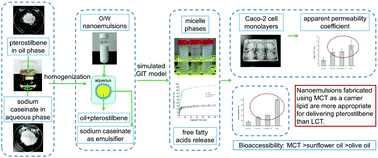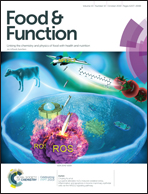Encapsulation of pterostilbene in nanoemulsions: influence of lipid composition on physical stability, in vitro digestion, bioaccessibility, and Caco-2 cell monolayer permeability†
Abstract
Pterostilbene as a functional food ingredient is limited by low water-solubility and low bioaccessibility. Recently, there has been growing interest to use nanoemulsions to encapsulate hydrophobic compounds. In particular, the lipid type plays a critical role in the efficacy of nanoemulsions. In this study, three different lipids (medium chain triglycerides (MCTs), sunflower oil, and olive oil) were each used as carrier lipids to fabricate nanoemulsions for delivery of pterostilbene. The impact of carrier lipid composition on the physical stability and in vitro digestion of each pterostilbene-loaded nanoemulsion was studied. Its effect on pterostilbene bioaccessibility and Caco-2 cell monolayer permeability of pterostilbene was also investigated. The saturation concentrations of pterostilbene in the three lipids were firstly determined. Nanoemulsions were subjected to in vitro digestion using a model simulating the gastrointestinal tract. Mixed micelles were thus obtained and analyzed for intestinal epithelial permeability using a Caco-2 cell monolayer model. The saturation solubility of pterostilbene in the tested lipids was ranked as follows: MCT > sunflower oil ≈ olive oil. The extent of free fatty acid release during lipid digestion decreased as follows: MCT > sunflower oil > olive oil. Bioaccessibility of pterostilbene followed a similar trend. The highest apparent permeability coefficient of pterostilbene was observed in MCT micelles, followed by sunflower oil or olive oil micelles. Our study indicated that nanoemulsions fabricated with MCTs were more effective for delivering pterostilbene than those produced with long chain triglycerides. Moreover, for long chain triglycerides, the higher unsaturation levels of lipids improved the lipid digestibility and pterostilbene bioaccessibility.



 Please wait while we load your content...
Please wait while we load your content...